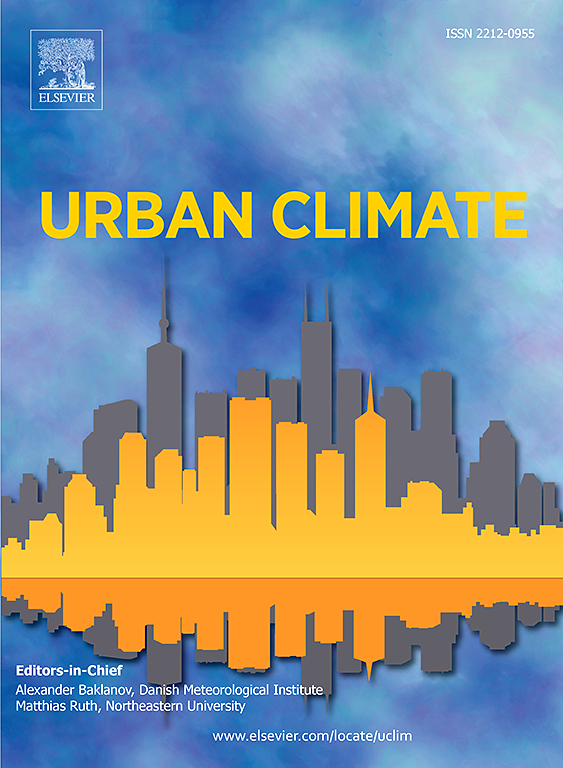Exploring suitable domain size for high-resolution urban rainfall simulation
IF 6
2区 工程技术
Q1 ENVIRONMENTAL SCIENCES
引用次数: 0
Abstract
High-resolution urban rainfall simulation is useful for understanding the interaction between urbanisation and local weather as well as the impact of climate change over cities and the impact of adaptation measures such as urban greening. Previous studies on mesoscale Numerical Weather Prediction (NWP) modelling have largely focused on spatial resolution and other aspects (e.g., spin-up time and model parameterisations), with limited investigations on how to determine a suitable domain size. Domain size is likely an important factor when the spatial resolution of modelling is within convection-permitting regime (less than 5 km). In this study, 64 summer domain tests are simulated with the Weather Research and Forecasting (WRF) model, over Newcastle upon Tyne, with ERA5 as input data and a radar product from the UK Met Office for validation. Using an integrated evaluation indicator, alongside spatial distribution maps, it has been found that too large or too small domain sizes both have negative impacts on the simulation results and an optimal domain size for the events here is identified. We find that domain size has a stronger influence on the event simulation than changing grid resolution within the range 1–4.5 km and thus should be a primary consideration. We also find that, for more accurate simulation, smaller domain sizes are better suited to heavy rainfall events than to lighter ones. In a similar way, smaller domain sizes perform better for rainfall events that cover larger spatial areas. Although the optimal domain size identified here is specific to the region/season, the sensitivities and relative influences are expected to be more generally applicable and show the importance of testing domain sizes before embarking on production simulations.
探索适合高分辨率城市降雨模拟的域大小
高分辨率城市降雨模拟有助于了解城市化与当地天气之间的相互作用,以及气候变化对城市的影响和城市绿化等适应措施的影响。以往对中尺度数值天气预报(NWP)建模的研究主要集中在空间分辨率和其他方面(例如,自旋时间和模式参数化),对如何确定合适的域大小的研究有限。当模拟的空间分辨率在对流允许范围内(小于5公里)时,区域大小可能是一个重要因素。在本研究中,使用天气研究与预报(WRF)模式在泰恩河上的纽卡斯尔上空模拟了64个夏季域测试,使用ERA5作为输入数据和英国气象局的雷达产品进行验证。利用综合评价指标,结合空间分布图,发现过大或过小的域尺寸都会对模拟结果产生负面影响,并确定了事件的最佳域尺寸。我们发现,在1-4.5 km范围内,区域大小比网格分辨率变化对事件模拟的影响更大,因此应该作为首要考虑因素。我们还发现,为了更精确的模拟,较小的域尺寸更适合于强降雨事件而不是较轻的降雨事件。以类似的方式,较小的域尺寸对于覆盖较大空间区域的降雨事件表现更好。虽然这里确定的最佳域大小是特定于区域/季节的,但其敏感性和相对影响预计将更普遍适用,并显示在开始生产模拟之前测试域大小的重要性。
本文章由计算机程序翻译,如有差异,请以英文原文为准。
求助全文
约1分钟内获得全文
求助全文
来源期刊

Urban Climate
Social Sciences-Urban Studies
CiteScore
9.70
自引率
9.40%
发文量
286
期刊介绍:
Urban Climate serves the scientific and decision making communities with the publication of research on theory, science and applications relevant to understanding urban climatic conditions and change in relation to their geography and to demographic, socioeconomic, institutional, technological and environmental dynamics and global change. Targeted towards both disciplinary and interdisciplinary audiences, this journal publishes original research papers, comprehensive review articles, book reviews, and short communications on topics including, but not limited to, the following:
Urban meteorology and climate[...]
Urban environmental pollution[...]
Adaptation to global change[...]
Urban economic and social issues[...]
Research Approaches[...]
 求助内容:
求助内容: 应助结果提醒方式:
应助结果提醒方式:


